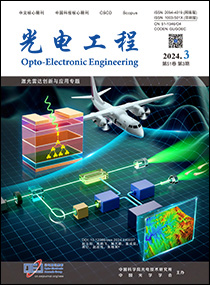2024 Vol. 51, No. 3
Special issue on innovation and application of LiDAR
Guest editor: Liu Bo,Institute of Optics and Electronics, CAS; Wu Guang, East China Normal University; Wu Songhua, Ocean University of China
Cover story: Zhao Y Y, Zhou P F, Xie T P, et al. Development status and trends of single-photon LiDAR technology[J]. Opto-Electron Eng, 2024, 51(3): 240037
In the field of 3D imaging detection, active laser LiDAR is widely used in aerospace, autonomous driving, 3D modeling, and environmental monitoring, among others. LiDAR based on single-photon detectors, through time-correlated single-photon counting technology, significantly reduces the imaging system's dependence on laser power and large-aperture optical systems, and provides a new solution for high-precision 3D reconstruction under weak signals, and becoming a development trend for the next generation of LiDAR technology.
The research team led by Researcher Zhu Jingguo reviewed development Status and Trends of Single-Photon LiDAR Technology (SPAD), introduces the basic principles of single-photon LiDAR technology, detection devices, imaging algorithms, and application examples. Focusing on detection technology based on SPAD, the article interprets existing single-photon imaging technologies from the perspective of single-photon device characteristics, organizes the research context of single-photon LiDAR, and discusses common issues and development trends of the technology.
Although there are still some issues to be resolved with LiDAR systems based on single-photon detectors, with the advent of high-performance, large-array SPAD detectors, the design of imaging algorithms that integrate multiple sources and sensing-computing, the launch of miniaturized, intelligent, and integrated system modules, and the increasing demand for broad applications, we believe that single-photon LiDAR will break through existing bottlenecks and demonstrate greater potential and value in both academic research and commercial applications in the future.

-
{{article.year}}, {{article.volume}}({{article.issue}}): {{article.fpage | processPage:article.lpage:6}}. doi: {{article.doi}}{{article.articleStateNameEn}}, Published online {{article.preferredDate | date:'dd MMMM yyyy'}}, doi: {{article.doi}}{{article.articleStateNameEn}}, Accepted Date {{article.acceptedDate | date:'dd MMMM yyyy'}}CSTR: {{article.cstr}}
-
{{article.year}}, {{article.volume}}({{article.issue}}): {{article.fpage | processPage:article.lpage:6}}. doi: {{article.doi}}{{article.articleStateNameEn}}, Published online {{article.preferredDate | date:'dd MMMM yyyy'}}, doi: {{article.doi}}{{article.articleStateNameEn}}, Accepted Date {{article.acceptedDate | date:'dd MMMM yyyy'}}CSTR: {{article.cstr}}

 E-mail Alert
E-mail Alert RSS
RSS


